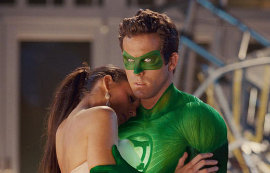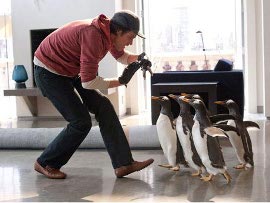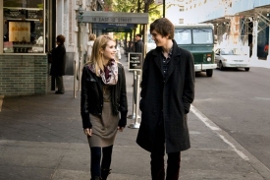 GREEN LANTERN
GREEN LANTERN
I won't bore you by trying, but I'm reasonably sure I could devote a few thousand words to what I didn't like about the (presumed) franchise-starter Green Lantern, an effects-heavy superhero adventure that might mark a new first for the on-screen-comic-book canon: Director Martin Campbell's movie is dully sardonic and dully sincere. I only need two words, however, to pinpoint everything I loved about the film: Peter Sarsgaard.
First seen as passive-aggressive science dweeb Hector Hammond, the actor's lightly frazzled intensity and pissiness provide subtle relief from all the high-minded blather about courage and duty, and from the low-wattage yuks of test pilot Hal Jordan (Ryan Reynolds) adapting to life as a spandex-clad protector of the universe. (Sarsgaard can make the simple act of sipping a pink daiquiri without using his hands look like the zenith in cleverness.) But once he's morphed into an insidious, psychopathic baddie with an Elephant Man cranium - the result of Hammond's accidental exposure to alien blood - Sarsgaard's already-committed and elegant turn explodes with feral imagination. Spitting out lines such as "Hal, hi!" and "Dad!" in ways that give you the chills while you're laughing, Sarsgaard seems less hindered than freed by being buried in latex (his portrayal reminded me F. Murray Abraham's craggy-old-man turn in Amadeus), and he emerges as a truly unsettling villain, easily the best that this summer's superhero flicks have yet provided. Among a supporting cast that includes such ill-used talents as Mark Strong, Tim Robbins, and Angela Bassett, Sarsgaard is the only one who looks like he's having a legitimately good time here, and whenever he was around, I was, too.
Unfortunately, Sarsgaard enters later than I'd have liked and leaves earlier than I'd have preferred, and there's all the rest of Green Lantern to consider. I knew I was in trouble pretty much from the start, when I chuckled, inappropriately, at the somber pronouncements from the eternally wise space-council leaders, with their flowing red robes and shrunken-apple heads; their humorless-Yoda declarations were silly enough, but considering the movie's reported $150-million budget, couldn't the filmmakers at least have synced the creatures' lips to match their dialogue? Yet all throughout the film, I giggled at the bits we were meant to take seriously and (Sarsgaard's scenes notwithstanding) remained stone-faced at the parts we were meant to find funny, and ended up just feeling bad for Reynolds, who's so overwhelmed by the incessant, mostly lackluster CGI that little of his deadpan, likable-lummox charm comes through. (When flying for the first time, even his joy appears to be computer-generated.) Reynolds doesn't possess the acting chops to make his retrograde, top-gun character interesting, but in his defense, no one facing such an onslaught of phony-looking visuals really could. Back in 1978, the advertising slogan for Superman the Movie was "You will believe a man can fly." Thirty-three years later, thanks to the cinematic "miracle" of CGI, I no longer believe that anyone can fly.
 MR. POPPER'S PENGUINS
MR. POPPER'S PENGUINS
Having just been reminded, in the startlingly subversive I Love You, Phillip Morris, that Jim Carrey can still deliver the comedic (and dramatic) goods when he wants to, I'll admit to dreading Mr. Popper's Penguins, the family slapstick in which Carrey's tightly wound real-estate whiz learns to loosen up and connect with his kids and blah blah blah with the aid of some squat, tuxedo-clad houseguests. But color me shocked: The movie's not bad at all. I mean, of course it's kind of bad; there's the requisite maudlin sentiment and the requisite assault of fart jokes, and even on its own terms, the storyline makes no sense. (The chief evildoer is a zookeeper who insists that the waterfowl aren't meant to be cooped up in a Manhattan penthouse. Could anyone of sound mind reasonably argue with this assessment?) Yet against all expectation, the movie works. It's fast-paced and agreeably goofy, and director Mark Waters stages some expert visual gags, none finer than the birds' exuberant slide through the Guggenheim. And leading a thoroughly winning cast that includes Carla Gugino, Angela Lansbury, David Krumholtz, and the superbly funny/creepy Clark Gregg, Carrey himself - his mugging as enjoyable as his unexpectedly sharp asides - is actually quite wonderful here. No one involved in the making of Mr. Popper's Penguins should feel at all embarrassed by their participation. It's the rest of us - including yours truly, who laughed out loud at the penguin-potty-training sequence - who might want to consider being embarrassed.
 THE ART OF GETTING BY
THE ART OF GETTING BY
After a double-feature of Green Lantern and Mr. Popper's Penguins, you'd think the low-key realism of writer/director Gavin Wiesen's teen drama The Art of Getting by - in which Freddie Highmore's discontented slacker George falls for Emma Roberts' wordly beauty Sally - would come as a blessed relief. And it might have, if the film's leads managed to deliver more than one facial expression apiece; Roberts is wistful and vacant, and Highmore is ... well, just vacant. (Describing George's wardrobe to a friend, Highmore says, "I like layers," which is ironic, because the young actor doesn't give us any.) With Highmore's ennui-laden youth reacting to every plot point with the same unvarying look of emotionally stunted affectlessness - be it the financial woes of George's parents (Rita Wilson and Sam Robards), the reprimands of his principal (Blair Underwood), or the disappointment of his English teacher (a nicely modulated Alicia Silverstone) - there's no drama to this drama. And Highmore has nothing in the way of sexual or even platonic chemistry with Roberts, not that it's easy to forge chemistry with a (sensationally lovely) block of wood.
Wiesen does stage one encounter, in which Sally asks George to sleep with her, with heart-stopping precision, and elicits a rather marvelous performance from Michael Angarano, as a bohemian artist who both George and Sally, for different reasons, attach themselves to. Aside from Roberts' prettiness and the film's smartly chosen Manhattan locations, Angarano - with his scruffy, apologetic charm and sad-eyed hipster charisma - gives you the only thing to really look at here, but it's quite possible that for its target demographic, the movie might have some pull. Leaving the auditorium where I saw The Art of Getting by, one of the teenage girls sitting two rows ahead of me said "That was so romantic I think I'm gonna die" to her friend - another teen who, as the whole audience surely noticed, spent most of the film texting. Rude though she was, I kinda sided with the texter.
Follow Mike on Twitter at Twitter.com/MikeSchulzNow.










